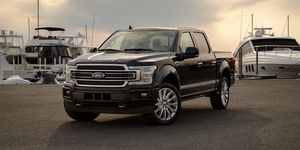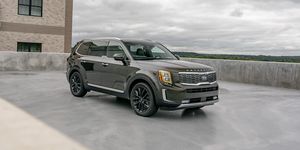- Overall, auto sales fell 27 percent in the first quarter in the U.S., business publication Wards Intelligence reported.
- While nearly all manufacturers saw a dramatic downturn in sales, SUV and pickup sales for some were much less dismal.
- Automakers’ biggest offerings have become increasingly popular in recent years, and even the coronavirus pandemic couldn’t halt that trend.
The spread of the coronavirus (COVID-19) forced a near-total shutdown of the U.S. economy in mid-March, and just as predicted, auto sales were strongly curbed as a result. New-vehicle sales fell for everyone in March, with an overall average of 27 percent, according to automotive research group Wards Intelligence.
For the ever-growing group of automakers that opt to report only quarterly, not monthly sales, the downturn couldn’t be hidden by otherwise normal sales numbers in January and February. For the first quarter, Ford saw sales drop 12.5 percent; Fiat Chrysler (FCA) sales fell 10.4 percent; GM’s declined by 7.1 percent. For the monthly reporters, sales fell anywhere between 35 and 50 percent in March.
Yet, for all the bad news, many automakers saw sales increases from their pickups and SUVs through the first quarter. For automakers such as FCA and GM, sales slumps were seen across their product lineups—with the exception of their larger offerings.
Sales of the Chevy Silverado, GM’s most popular pickup, surged 26.6 percent in the first quarter of 2020 as compared to the year prior, and sales for the GMC Sierra jumped 30.7 percent. All said, the pickups comprised nearly a third of all of GM’s sales, up nearly 10 percent from a year ago. It was the best first quarter for the company’s full-size pickups since 2007.
In 2019, Ram pickups outsold the Silverado for the first time ever, but the uptick in Ram sales this past quarter couldn’t keep up with Chevy this time around. Ram saw pickup sales climb 7 percent in the first quarter, making it one of three FCA models—the others are the Dodge Durango and the Chrysler Pacifica—to see positive sales in the previous three months.
Nonetheless, while Ford maintained its first-place position in the truck wars, F-150 sales dropped 13.1 percent. In the sales release, Ford said the timing of fleet sales as well as the spread of COVID-19 pushed sales down for its biggest seller.
Beyond the Detroit Three, trucks—and for some, crossovers—held their ground through the first quarter. Notably, Kia, up 1 percent for the quarter, was one of the few brands that saw sales increases in multiple models of its lineup and was one of the only ones (among automakers that release monthly sales) to have a model see an increase in March sales. The automaker’s biggest offering, the Telluride, saw an increase in sales of just over a percent.
For Honda, including Acura, quarterly sales increases were seen among three of its models, the Fit, Ridgeline, and Passport, the latter two being among the biggest offerings from the Japanese automaker. Nonetheless, sales of the popular Pilot declined through the quarter.
Pickup sales for the Detroit Three were helped by record incentives averaging $7200 in the last days of the month, according to J.D. Power. Both FCA and GM offer buyers with top-tier credit zero-percent loans for up to 84 months and deferred payments up to 90 days on new vehicles. Ford is offering up to three months of deferred payments and will pay for another three months, for six months of total payment assistance.
SUV and pickup market share has ballooned in the last decade, reaching 70 percent in 2019. Although unemployment claims have reached historic numbers and consumer confidence is being rocked, the biggest vehicles from automakers thwarted some of the impact of COVID-19 in March (although quarterly data obscures some of the extent of that).
The ability of cheap gas and high incentives to keep SUV and pickup sales strong will be tested in coming months, but the success of that won’t be seen until the beginning of July, or the end of the second quarter.
Source: Motor - aranddriver.com







